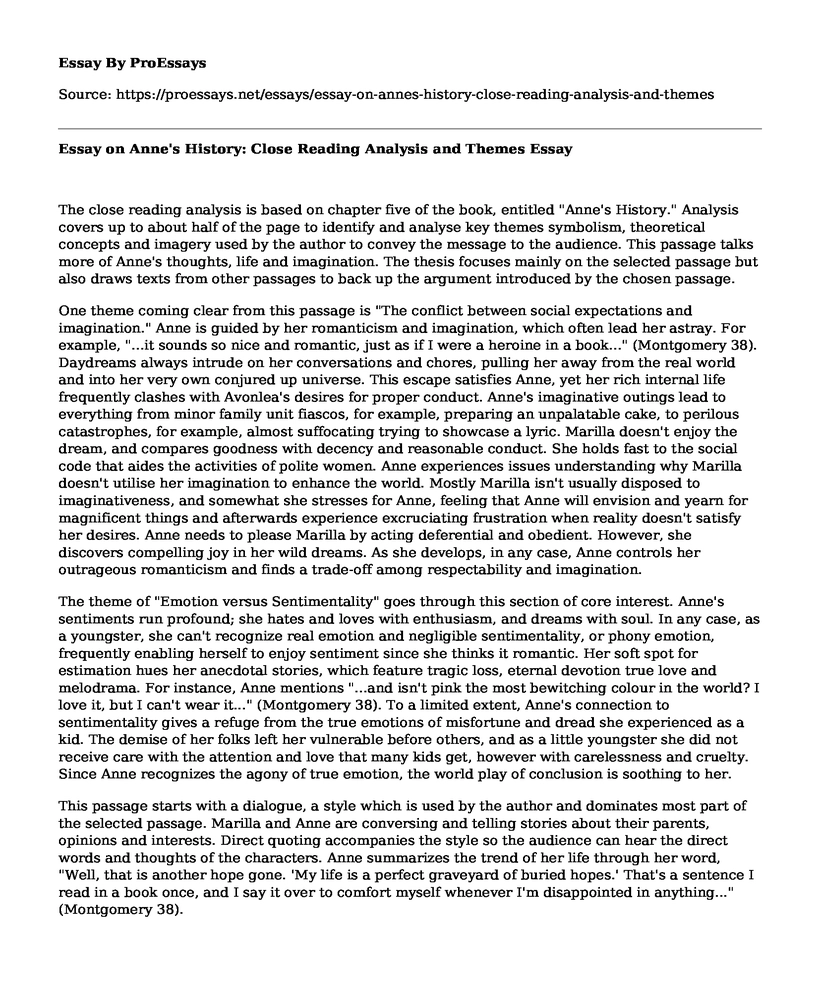The close reading analysis is based on chapter five of the book, entitled "Anne's History." Analysis covers up to about half of the page to identify and analyse key themes symbolism, theoretical concepts and imagery used by the author to convey the message to the audience. This passage talks more of Anne's thoughts, life and imagination. The thesis focuses mainly on the selected passage but also draws texts from other passages to back up the argument introduced by the chosen passage.
One theme coming clear from this passage is "The conflict between social expectations and imagination." Anne is guided by her romanticism and imagination, which often lead her astray. For example, "...it sounds so nice and romantic, just as if I were a heroine in a book..." (Montgomery 38). Daydreams always intrude on her conversations and chores, pulling her away from the real world and into her very own conjured up universe. This escape satisfies Anne, yet her rich internal life frequently clashes with Avonlea's desires for proper conduct. Anne's imaginative outings lead to everything from minor family unit fiascos, for example, preparing an unpalatable cake, to perilous catastrophes, for example, almost suffocating trying to showcase a lyric. Marilla doesn't enjoy the dream, and compares goodness with decency and reasonable conduct. She holds fast to the social code that aides the activities of polite women. Anne experiences issues understanding why Marilla doesn't utilise her imagination to enhance the world. Mostly Marilla isn't usually disposed to imaginativeness, and somewhat she stresses for Anne, feeling that Anne will envision and yearn for magnificent things and afterwards experience excruciating frustration when reality doesn't satisfy her desires. Anne needs to please Marilla by acting deferential and obedient. However, she discovers compelling joy in her wild dreams. As she develops, in any case, Anne controls her outrageous romanticism and finds a trade-off among respectability and imagination.
The theme of "Emotion versus Sentimentality" goes through this section of core interest. Anne's sentiments run profound; she hates and loves with enthusiasm, and dreams with soul. In any case, as a youngster, she can't recognize real emotion and negligible sentimentality, or phony emotion, frequently enabling herself to enjoy sentiment since she thinks it romantic. Her soft spot for estimation hues her anecdotal stories, which feature tragic loss, eternal devotion true love and melodrama. For instance, Anne mentions "...and isn't pink the most bewitching colour in the world? I love it, but I can't wear it..." (Montgomery 38). To a limited extent, Anne's connection to sentimentality gives a refuge from the true emotions of misfortune and dread she experienced as a kid. The demise of her folks left her vulnerable before others, and as a little youngster she did not receive care with the attention and love that many kids get, however with carelessness and cruelty. Since Anne recognizes the agony of true emotion, the world play of conclusion is soothing to her.
This passage starts with a dialogue, a style which is used by the author and dominates most part of the selected passage. Marilla and Anne are conversing and telling stories about their parents, opinions and interests. Direct quoting accompanies the style so the audience can hear the direct words and thoughts of the characters. Anne summarizes the trend of her life through her word, "Well, that is another hope gone. 'My life is a perfect graveyard of buried hopes.' That's a sentence I read in a book once, and I say it over to comfort myself whenever I'm disappointed in anything..." (Montgomery 38).
The author has used symbolism to expose Anne's expectation of places. Anne wants to re-name everything. All things considered nearly everything. She thinks the name of her new home, Green Gables, in Avonlea, is a great idea to go. However, she needs to rename everything else, from her very own name to the names of beautiful places around the local area. Her fixation on language originates from perusing plenty of books, and it's tied in with needing the names of spots to reflect how delightful they look. An example in this entry is demonstrated when she renames Barry's pond, the lake of Shining Waters to alert the audience how delightful the spot looks. "...Are we going across the Lake of Shining Waters today? We're not going over Barry's pond if that's what you mean by your Lake of Shining Waters..." (Montgomery 38).
Imagery is evident by the statement "Mrs. Thomas said that they were a pair of babies and as poor as church mice..." (Montgomery 38). The phrase as poor as church mice is a simile. A simile compares two different items in a fascinating manner. The degree of poverty is compared with that of a church mice meaning the circumstance is outrageous. The object of a simile is to start an intriguing association with regards to a reader's or audience's psyche. The expression in this entry has been utilised by the writer to make writing all the more powerful, vivid and to pass message effectively and quickly.
Works Cited
Montgomery, Lucy Maud. Anne of Green Gables. Gutenberg, 2004: 38. Retrieved from http://www.gutenberg.org/files/45/45-h/45-h.htm
Cite this page
Essay on Anne's History: Close Reading Analysis and Themes. (2023, Feb 11). Retrieved from https://proessays.net/essays/essay-on-annes-history-close-reading-analysis-and-themes
If you are the original author of this essay and no longer wish to have it published on the ProEssays website, please click below to request its removal:
- Literary Essay - The Stylistic Devices Used to Present the Theme of Paralysis in Joyce's Dubliners
- The Growth of Hamlet: Literary Analysis Essay
- Diagnosing Abigail Williams in Crucible by Arthur Miller
- Response to Maus' Interpretation of Shakespearean Comedy Essay
- The Fall of the House of Usher Chapter One Passage Analysis Essay
- Essay Example on The Twelve Greek Pantheons: Immortals of Greek Mythology & Religion
- Maverick, Uncle Carlos, and Fatherhood in The Hate U Give Paper Example







